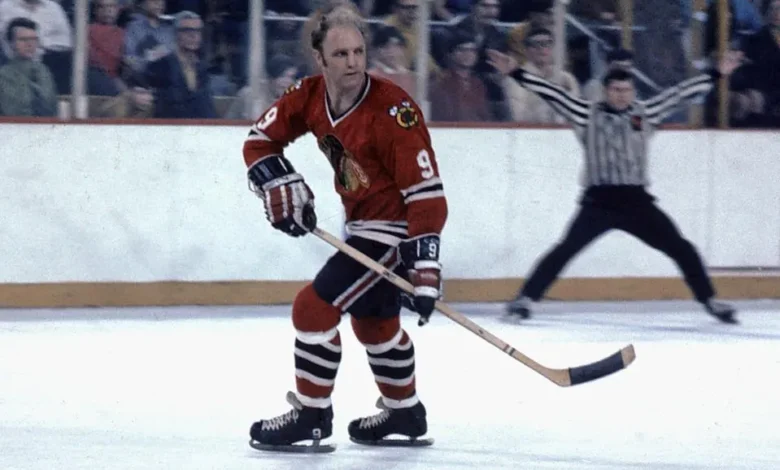Bobby Hull’s CTE Diagnosis: A Hockey Icon’s Final Contribution
The NHL’s Stance on CTE and the Ongoing Fight for Player Safety

BOSTON — Hockey Hall of Famer and two-time Hart Trophy winner Bobby Hull was posthumously diagnosed with chronic traumatic encephalopathy (CTE), the most prominent former NHL player to suffer from the debilitating brain disease that results solely from repeated blows to the head.
Bobby Hull Posthumous CTE Diagnosis:
The findings of Hull’s diagnosis were announced Wednesday by the Concussion Legacy Foundation in collaboration with Hull’s widow, more than two years after he died at the age of 84 and quietly donated his brain to science.
“Seeing the pain and heartache endured by the family of his lifelong friend Stan Mikita, Bobby felt strongly that no other family should have to face CTE,” Hull’s wife of 39 years, Deborah Hull, told CLF. “He insisted on donating his brain, feeling it was his duty to help advance research on this painful disease.” Hull diagnosed with stage 2 CTE; There are four stages of this disease. Deborah Hull told CLF that Hull struggled with “many cognitive symptoms of CTE, such as short-term memory loss and decreased decision-making ability” for the last 10 years of her life. Hull’s family contributed his brain to the UNITE Brain Bank at Boston University’s CTE Center.
Hull’s family contributed his brain to the UNITE Brain Bank at Boston University’s CTE Center. While there are certainly some big-name NHL players, including Mikita, Bob Probert and Derek Boogaard — none of them have a resume like Hull’s. Known as “The Golden Jet”, Hull led the NHL in goal scoring seven times, won three Art Ross Trophies as the league’s leading point getter and finished in the top three in Hart Trophy voting, including his two MVP seasons. In 1972, he became the first professional hockey player to earn a million-

dollar salary, which was as incredible as it was unprecedented, when he moved from the NHL to the WHA with the upstart Winnipeg Jets.
When his WHA accomplishments are taken into account, only two players in pro hockey history have scored more than Hull’s 1,018 goals – slightly ahead of Wayne Gretzky and Gordie Howe – when both the regular season and playoffs are included.
In total, Hull played 23 professional seasons and 1,474 regular season games in the two leagues. Most of those games were played without helmets. Interestingly, Hull was photographed wearing a helmet with a football-style facemask much earlier. He sometimes wore a helmet while playing in the WHA. Helmets were not mandated by the NHL until 1979 and were grandfathered in for all players playing before that; Hull retired after the 1979–80 season.
To this day, the NHL and Commissioner Gary Bettman have refused to acknowledge the connection between hockey and repeated hits to the head and CTE. They are one of the last professional sports leagues not to acknowledge CTE, and have cited the need for more research. A study conducted by BU found that the chance of developing CTE increases by 34 percent for each year of playing professional hockey.
“NHL families deserve to know that CTE can be the result of hits they take to the head while playing games,” CLF CEO Chris said in a release. “The NHL still shamelessly refuses to acknowledge this scientific truth, so we hope this message gets across to current players so they can at least play with informed consent.”
To that end, NHLPA Executive Director Marty Walsh became the first person with power at hockey’s highest level to not only acknowledge CTE, but take a step toward learning more about it in order to combat it. In November, Walsh announced the formation of the association’s first CTE Advisory Committee, initially comprised of 10 players but planned to include representatives from all 32 teams.
The NHLPA voted unanimously to form the committee. said that when he was selected for his role, he learned during the NHLPA’s executive search how important it was for current players to learn more about CTE — where he also heard how important it is to get back to the best game at the international level.
“I realized we needed to take action,” Walsh shared with Daily Faceoff in November. “It’s crucial for us to conduct our own research so that players can grasp the complete implications of CTE.” You have to understand the importance and benefits of playing professional hockey, but you also have to look at the other side of the coin – the physical well-being of the players and what it does to their heads.”
Dr. Ann McKee, the director of BU’s CTE Center, urged retired players and their families to reach out to CLF for assistance and care if CTE is suspected, particularly regarding effective treatment for symptoms, “especially in mid-life.” Hull was a larger-than-life figure, known for his powerful shot and distinctive raspy voice, but he also had a tumultuous off-ice history. He was arrested in 1986 on assault and battery charges after police told the Associated Press they had evidence against him.
Hull was a man of great personality, with a fiery shot and a raspy voice, and a checkered history off the ice as well. He was arrested on assault and battery charges in 1986, after police told the Associated Press they had evidence that he had struck his wife Deborah in the face, and his previous marriage had ended in divorce after several alleged abusive incidents. He died on January 30, 2023, at the age of 84.